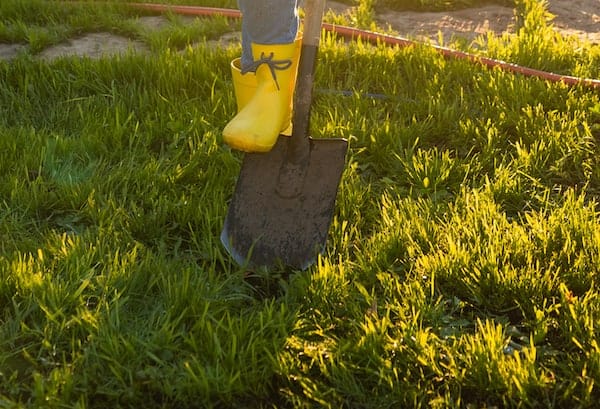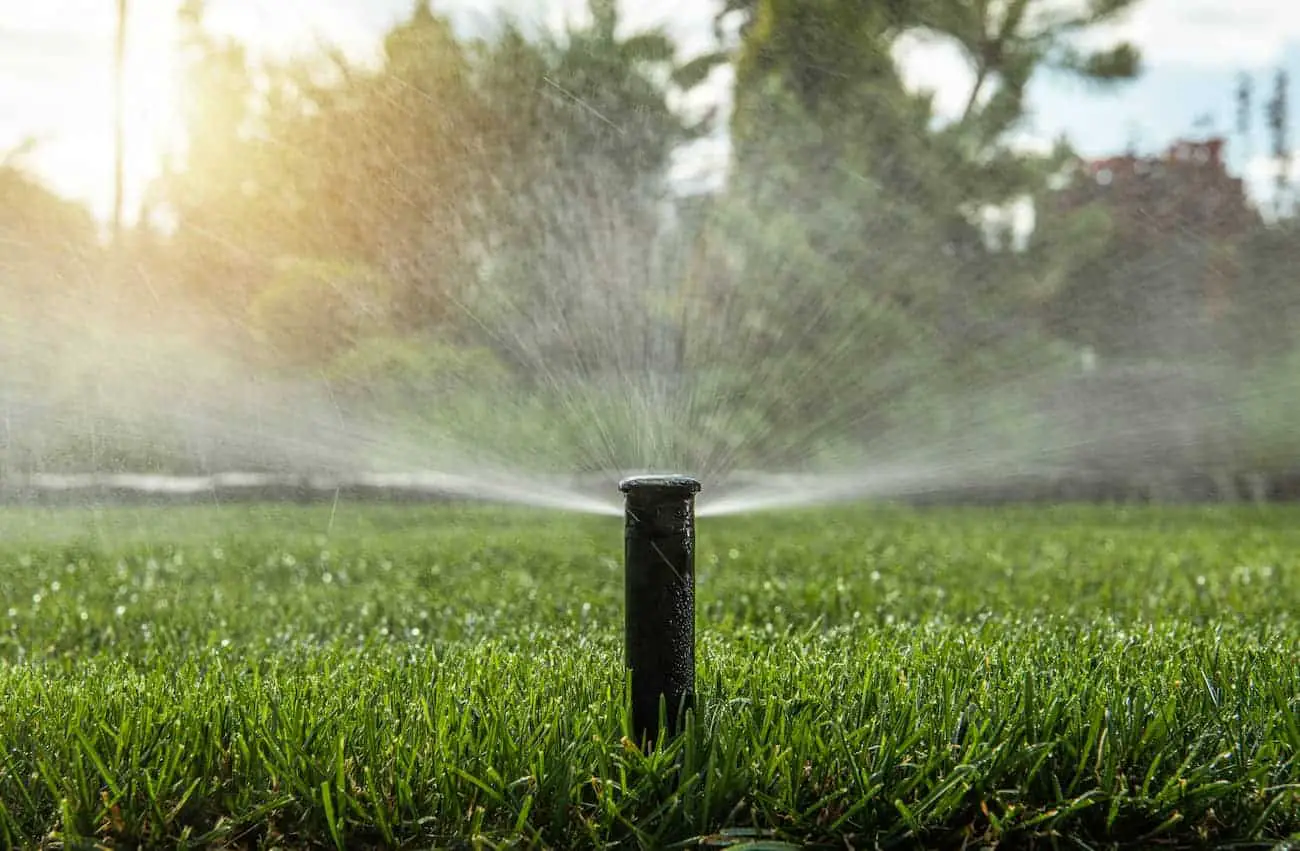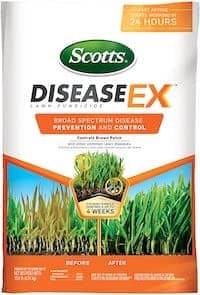What is Dollar Spot Fungus?
Dollar Spot Fungus, also known as dollar spot disease, is an environmentally related lawn fungus that can cost you a lot of money. It causes turfgrass to turn brown and die in circular patches about 12 inches in diameter. Fungal spores are spread by rain or irrigation water and this fungus thrives on stressed grasses with excess nitrogen levels. This is why it’s important to fertilize your lawn so that it has the right balance of nutrients for healthy growth. Dollar Spot Treatment for your lawn is essential if you want to avoid being faced with large areas of dead grass!
 What Causes Dollar Spot Fungus?
What Causes Dollar Spot Fungus?
Dollar Spot Fungus is caused by a fungus called Sclerotinia homoeocarpa. This fungus thrives in soil with high nitrogen levels, which can cause lawns to become stressed and more susceptible to dollar spot infection.
It’s important to maintain healthy nitrogen levels so that your turfgrass remains green and disease-free!
Dollar Spot Fungus is not just a lawn problem – it’s also related to the environment. It thrives in areas where nitrogen levels are high due to fertilizing or overuse of turfgrass and rainwater spreads spores from infected plants onto healthy ones. A dollar spot treatment will help kill off any new infections that can be caused by this environmental condition.
If you want beautiful green grass year-round without any problems from dollar spot disease then make sure to take care of it so that this doesn’t happen! Here are some tips for dealing with dollar spot fungal infections along with what causes them. Read on for more information about how you can avoid dealing with this lawn fungus!
 How Do You Prevent Dollar Spot Fungus?
How Do You Prevent Dollar Spot Fungus?
One way to prevent dollar spot fungus is by fertilizing in the late summer, which helps maintain healthy levels of nitrogen. You can also choose a lawn with a lower risk for fungal infection such as Kentucky Bluegrass or Bermuda Grass since these types have some natural resistance against this problem.
Another way to avoid getting Dollar Spot Fungus on your lawn and killing off areas where it already exists is by applying fungicide during periods when you are more likely to get infected.
This is especially important if you live in an area that has higher humidity, rainfall, and temperature ranges!
It’s important not only to treat surfaces after they’re contaminated but also to identify what causes dollars spots so that you know how best to prevent them from happening in the first place!
How Do You Treat Dollar Spot Fungus?
There are two ways to treat dollar spot fungus. The first treatment is by applying a fungicide that contains either metalaxyl, dithiopyr, or oxadixyl. The other option is using lawn sand which removes infected grass blades from the top of your turfgrass until it has reached healthy levels again.
How to Treat Dollar Spot Fungus with Fungicide:
After you’ve diagnosed dollar spot fungal infection, it’s time to treat the fungus with a fungicide. Here are some steps on how best to deal with this environmental problem:
Apply a Fungicide soon after diagnosis because Dollar Spot can spread rapidly and is more difficult to remove when established. Make sure that any surfaces touched by the spores of dollar spot disease are treated with the fungicide as well (e.g., water hose).
Use only approved treatments for lawns such as those containing chlorothalonil, mancozeb, or trichlorfon.
How to Treat Dollar Spot Fungus with Lawn Sand:
It is possible to remove the infected grass blades from the top of your turfgrass until it has reached healthy levels again by using lawn sand. This remedy for dollar spot fungus removes all infected grass and prevents new growth, which helps keep this problem from spreading any further in your yard. Here are some steps on how best to deal with this environmental problem:
- Dig out a trench around each dollar spot site one foot deep or more.
- Cover surface area created by digging with at least three inches of clean dry soil (preferably finished compost). The trench should be wide enough so that when you fill it back up there will be good contact between damp soil and dry soil – try not to compact dirt too much as you work.
- Apply a light dressing of lawn sand over the trench and then rake back to blend in with the rest of your yard. The area that was treated should be kept damp for at least one week after filling trenches, raking soil, and applying sand.
This is an organic way to remove infected grass blades from your healthy turfgrass without using any chemicals or fungicides! For best results, do not apply more than once per year but this will depend on how severe dollar spot fungus has become.
This treatment takes about three hours because it requires digging out the trench around each dollar spot site one foot deep or more. Digging cannot be done during rainy weather; wait until dry periods before continuing work (e.g., September). Keep applying lawn sand until the trench is filled and then rake back to blend in with the rest of your yard.

Related Questions
What does dollar spot fungus look like?
Dollar spot fungus is a brown, circular patch that can be found on your lawn and resembles the shape of coins. It can vary in size from one to six inches but will most likely start out as small patches that are not very noticeable until they spread across large areas of your yard.
The discoloration is due to dead plant cells left behind when fungi break down these tissues for food and nutrients. Fungi need moisture (so you’ll find dollar spot fungus more often during moist or rainy seasons) and cool temperatures (temperatures above 70 degrees Fahrenheit). You’re also more at risk if you have high humidity levels because this creates an environment where spores thrive!
Will lawn fungus go away on its own?
No, lawn fungus is a persistent disease that will continue to spread until you take the necessary steps.
Does Scotts Disease Ex treat dollar spot?
Yes, you’ll need a fungicide to get rid of dollar spot fungus and Scott’s Disease Ex can get the job done. There are also other fungicides available so talk to your local lawn care professional for recommendations and the best way to apply them. Also make sure that any surfaces touched by the spores of dollar spot disease (e.g., water hose) are treated with the fungicide as well. If possible, use only approved treatments for lawns such as those containing chlorothalonil, mancozeb, or trichlorfon.
Can grass recover from fungus?
Not on its own. Dollar spot fungus is a persistent disease that will continue to spread until you take the necessary steps – for example, applying lawn sand and keeping it damp for at least one week. Do not apply more than once per year though as this can be harmful to your turfgrass! For best results, make sure any surfaces touched by the spores of dollar spot disease (e.g., water hose) are treated with fungicide too so they don’t become infected themselves.
Keep in mind there are many types available but talk to your local lawn care professional for recommendations and how to apply them before doing anything else!
In conclusion, follow the instructions above to keep your lawn fungus-free. The key is prevention but there are ways to get your lawn looking beautiful again through treatment with fungicides. Make sure to follow the directions and give your lawn time to heal.


